Our special fall crowd-funder is going on now. Please donate today to help EarthSky keep going!
Whoa! 2 comets are coming!
Not one but two bright comets might soon grace Earth’s skies! And EarthSky.org has the lowdown on both. Watch a replay of our LIVESTREAM here or in the player above, where we offered the latest information on these visitors to the inner solar system. See the best Comet A3 Tsuchinshan-ATLAS images here. Plus! We offer many livestreams every week at 12:15 pm CT (17:15 UTC). Don’t miss a thing, click on the notify me button, here.
October 8 evening: Moon lies near Antares
On the evening of October 8, 2024, the bright red star Antares, the Heart of Scorpius the Scorpion, will lie close to the growing waxing crescent moon.
Read: Antares, a massive red star
Our charts are mostly set for the northern half of Earth. To see a precise view – and time – from your location, try Stellarium Online.

Read: What’s that bright star by the moon? A preview of the moon and Venus for the coming months
October moon phases
Marcy Curran – voice of the night sky at EarthSky YouTube – previews moon phases for the month of October. See when the moon will be near visible planets and bright stars. Want more? Here are 4 keys to understanding the moon’s phases.
October 9 and 10 evenings: Moon near Teapot
On October 9, 2024, the waxing crescent moon will glow among the stars of the Teapot, an asterism in Sagittarius the Archer. Then on October 10, the 1st quarter moon will lie near the Teapot. They’ll be visible until late evening your local time. When you gaze toward the Teapot, you’re gazing toward the center of the Milky Way galaxy, our home galaxy.
Read: Teapot of Sagittarius points to Milky Way center

October 10: 1st quarter moon
The moment of 1st quarter moon will fall at 18:55 UTC (1:55 p.m. CDT) on October 10, 2024. A 1st quarter moon rises around noon your local time and sets around midnight. Watch for a 1st quarter moon high in the sky at sundown. Want more? Here are 4 keys to understanding the moon’s phases.
October morning planets: Mars
In October 2024, red Mars will slide by the twin stars of Gemini, Castor and Pollux. The red planet is now rising before midnight and can be seen in the sky before dawn. It’s getting brighter, as Earth sweeps up from behind Mars in the race of the planets around the sun. Earth will pass between Mars and the sun in January 2025. Then Mars will be opposite the sun, at its once-in-two-years opposition. Watch, as Mars brightens over the coming months and shifts rapidly toward the evening sky. Get Mars updates, here.
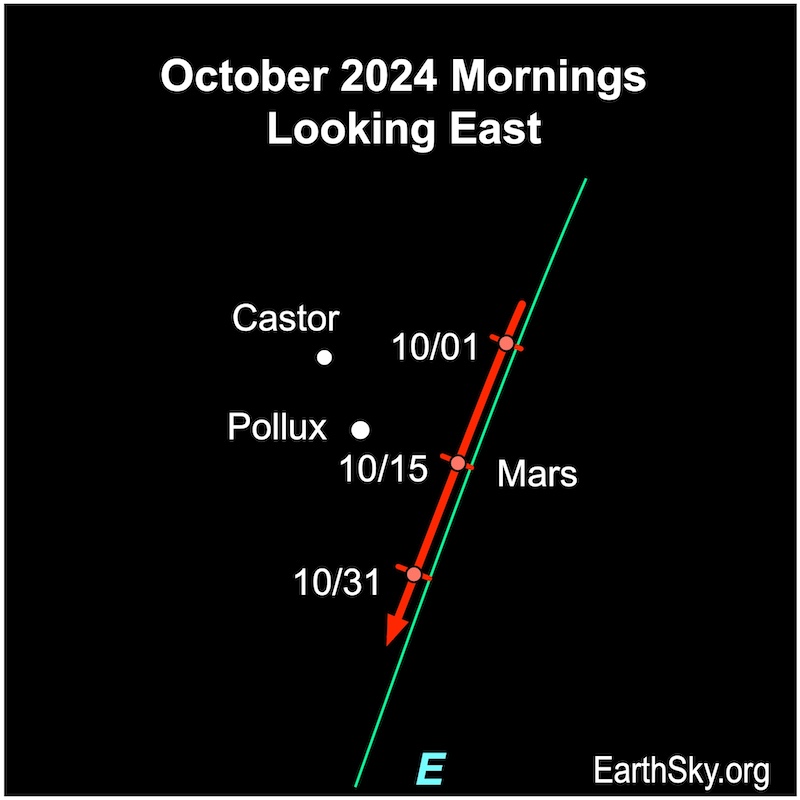
October 13 and 14 evenings: Moon near Saturn
The bright waxing gibbous moon will hang near Saturn in the east after sunset on the evenings of October 13 and 14, 2024. Observers visible from Asia and Africa will see the moon occult Saturn at 18 UTC on October 14. They’ll set a few hours before dawn. Did you know that Saturn’s rings are sometimes wide open as seen from Earth, and sometimes appear to us as edgewise. The rings are closing now. By March of 2025, they’ll be so perfectly edgewise that, for a time, they’ll disappear!
Read: Saturn’s rings are disappearing!
Our charts are mostly set for the northern half of Earth. To see a precise view – and time – from your location, try Stellarium Online.
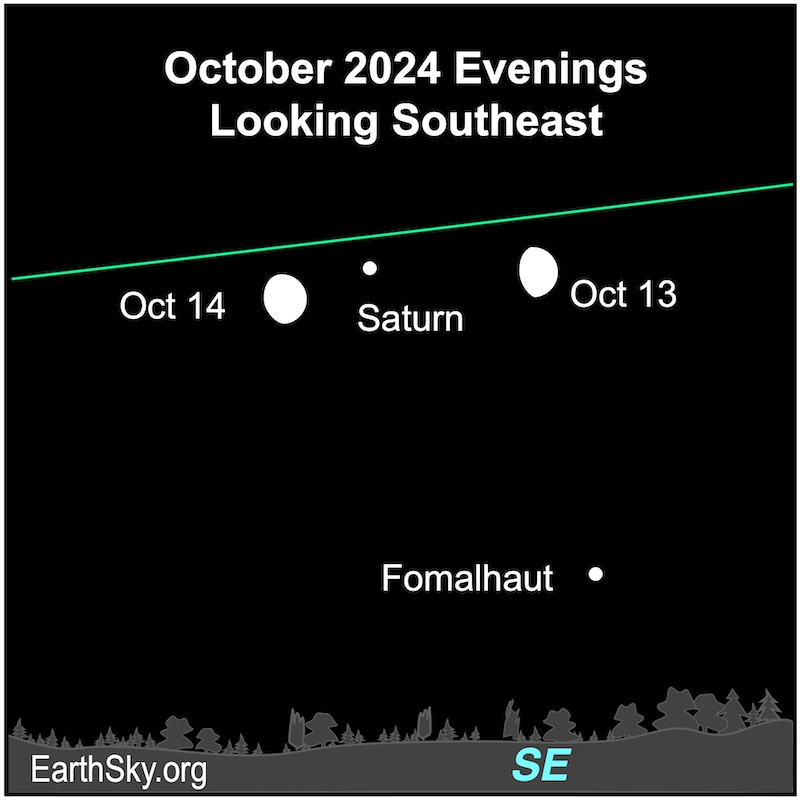
October 14 to 24: Comet Tsuchinshan–ATLAS at its brightest
It’s been a while since we’ve had a wispy comet tail stretch across our evening sky. If we are fortunate, a comet will grace our sky from October 14 to 24. Look to the west shortly after sunset for Comet Tsuchinshan–ATLAS. Around then, a beautiful, graceful cometary apparition might be in store for us. That’s when Comet Tsuchinshan–ATLAS could be bright in the early evening sky. And stay tuned, we might have another bright comet toward the end of October.
Read: Can you see Comet A3 Tsuchinshan-ATLAS with the unaided eye?
Read: Wow! Another one! Big new sungrazer comet could get SUPER-bright
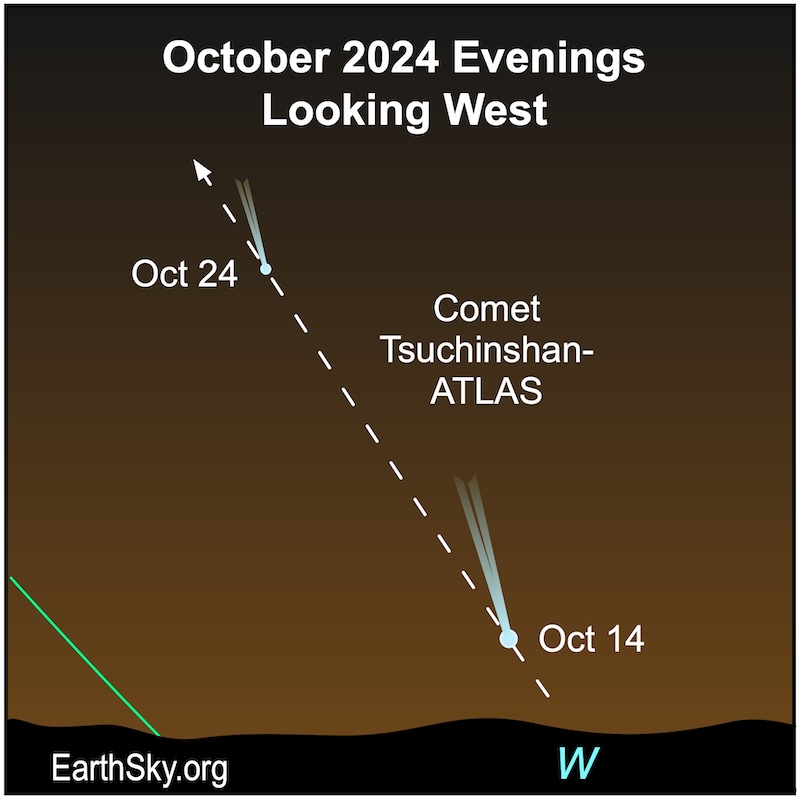
October 17: Moon reaches perigee
The moon will reach perigee – its closest point in its elliptical orbit around Earth – at 1 UTC on October 17, 2024 (8 p.m. CDT om October 16), when it’s 221,937 miles (357,174 km) away. A close moon can herald high tides, called spring tides. But the sun plays a role, too. Tides, and the sun of the sun and moon, here.
October 17: Super Hunter’s Moon
The moment of full moon will fall at 11:26 UTC on October 17, 2024 (6:26 a.m. CDT). A full moon rises opposite the sunset, is highest in the sky at midnight and lies low on the western horizon opposite the sunrise. This is the third of four supermoons in a row. And it’s the Hunter’s Moon, plus it’s the closest – largest and brightest – supermoon in 2024. Want more? Here are 4 keys to understanding the moon’s phases. Also, enjoy 3rd of 4 Supermoons in a row in 2024 is the Super Hunter’s Moon.
Read about the Hunter’s Moon in 2024: All you need to know
October 18 and 19 evenings: Moon near Jupiter, Aldebaran and the Pleiades
Soon after sunset on October 18 and 19, 2024, the waning gibbous moon will move closer to the bright planet Jupiter. The Pleiades star cluster will shine nearby and will be closest to the moon on October 19. Plus the fiery orange star Aldebaran, the Eye of Taurus the Bull, will shine near Jupiter. They’ll be visible through dawn.
Read more: The Pleiades – or 7 Sisters – known around the world
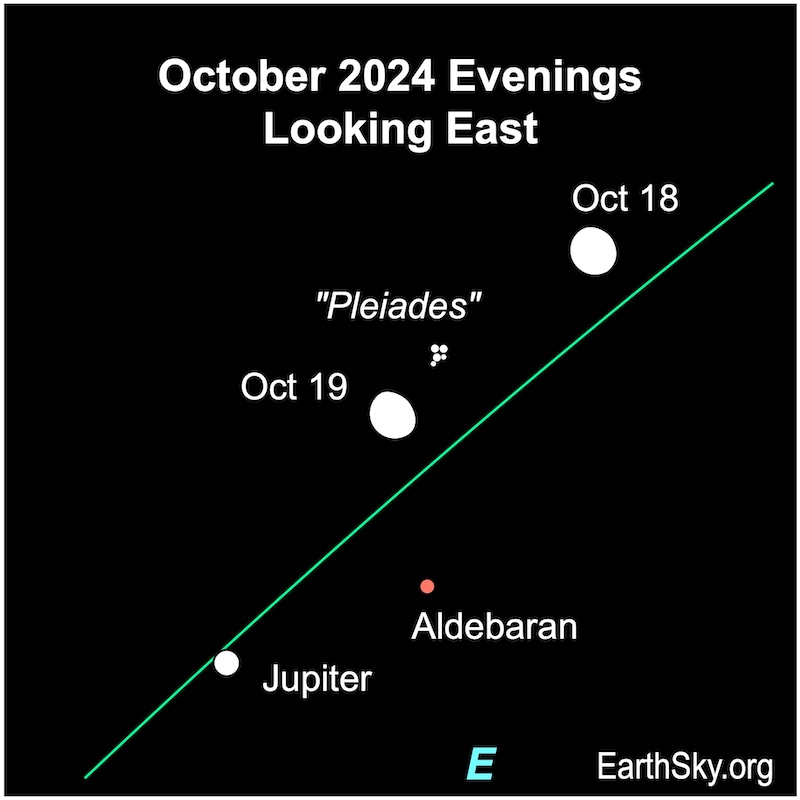
Orionid meteor shower around October 20
The greatest number of Orionid meteors should zip across the sky on the mornings of October 20 and 21. But they’ll be competing with a waning gibbous moon. Under ideal conditions you might see up to 20 meteors per hour. Here’s our Orionid meteor shower 2024: All you need to know. And for upcoming meteor showers here’s the Meteor Shower Guide 2024.
October 20 evening: Moon near Jupiter
On the evening of October 20, 2024, the waning gibbous moon will slide between the planet Jupiter and Capella, the brightest star in Auriga the charioteer. Near Jupiter lies the giant star Aldebaran, the fiery eye of Taurus the Bull. Also, the shimmering glow of the delicate Pleiades star cluster will be nearby. They’ll rise a few hours after sunset and be visible through dawn. Find out when Jupiter will be biggest and brightest in 2024 here.
Our charts are mostly set for the northern half of Earth. To see a precise view – and time – from your location, try Stellarium Online.
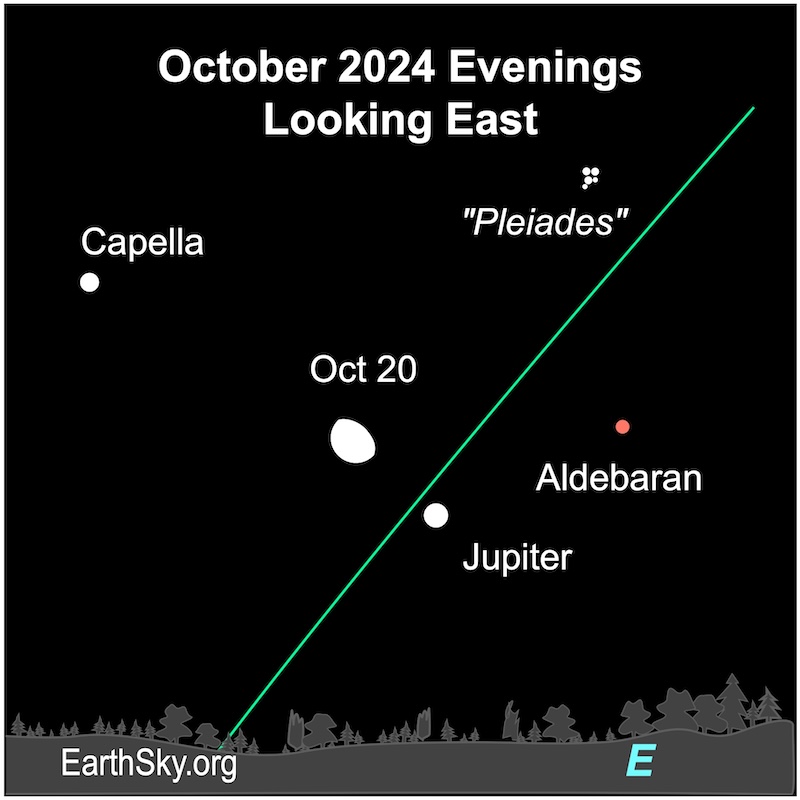
October 22 and 23 mornings: Moon near Jupiter, Mars, Castor and Pollux
On the mornings of October 22 and 23, 2024, the waning gibbous moon will slide near Jupiter, Mars and the twin stars of Gemini, Castor and Pollux. They’ll rise before midnight the night before and be visible through dawn. Read Mars updates for 2024, here.
Our charts are mostly set for the northern half of Earth. To see a precise view – and time – from your location, try Stellarium Online.
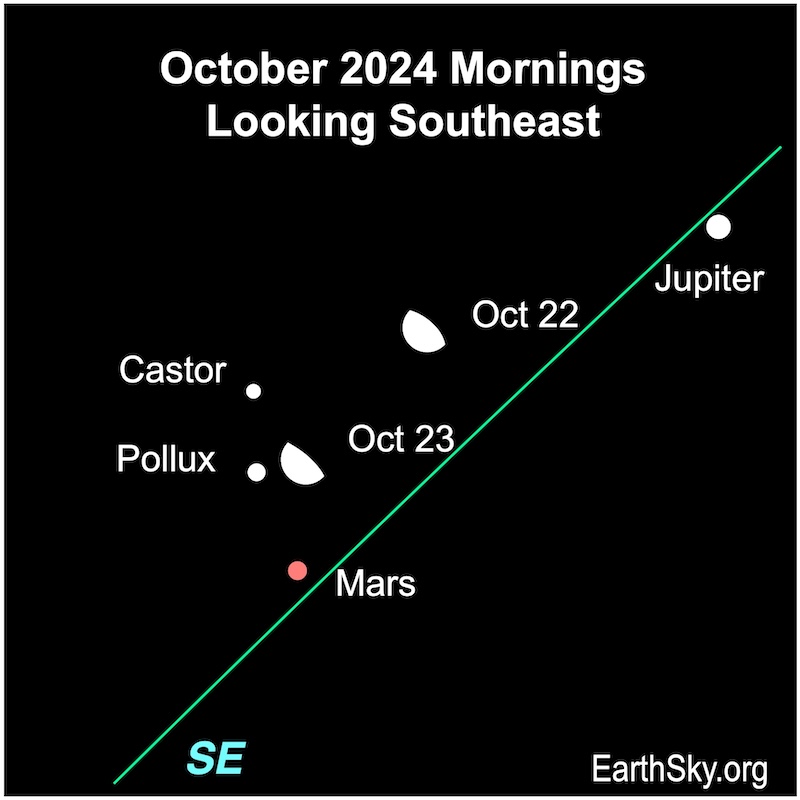
October 24: Last quarter moon
The moment of last quarter moon will fall at 8:03 UTC (3:03 a.m. CDT) on October 24, 2024. It’ll rise after midnight your local time and will set around noon. Look for it high in the sky before dawn. Want more? Here are 4 keys to understanding the moon’s phases.
October 24 morning: Moon and Beehive binocular view
Binoculars will help show the Beehive star cluster next to the waning crescent moon on the morning of October 24, 2024.
Want more? Binoculars for stargazing: Our top 6 tips here
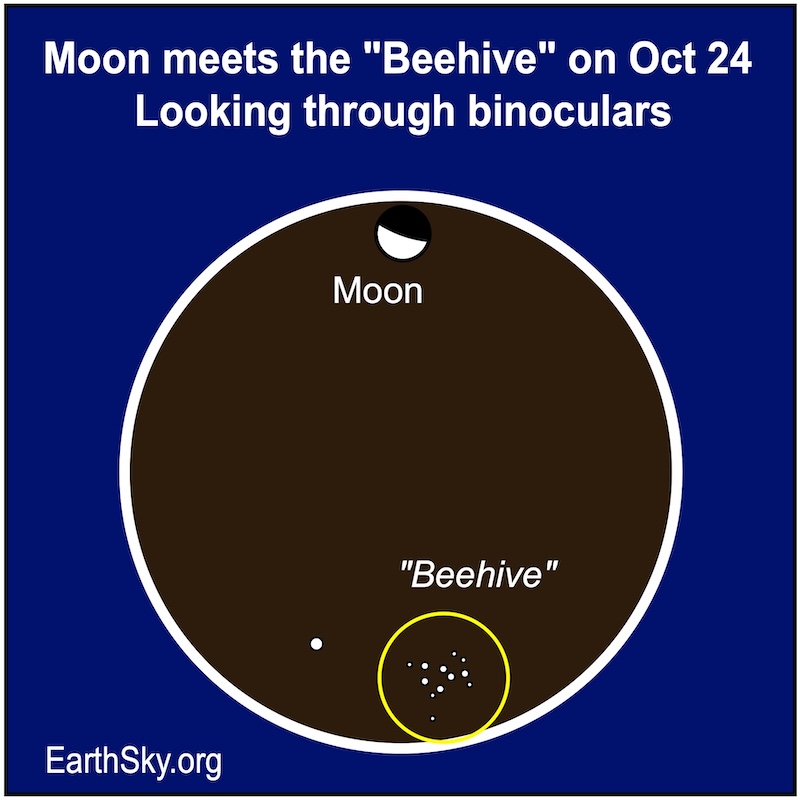
October 24 and 25 mornings: Moon buzzes by the Beehive
Before dawn on October 24 and 25, 2024, the waning crescent moon will move close to the faint Beehive star cluster. In a dark sky, the Beehive is an easy target with binoculars. Also nearby are the twin stars of Gemini, Castor and Pollux. They’ll rise around midnight and be visible through dawn.
Do you love open star clusters? Read more: Open star clusters are loose groups of stars
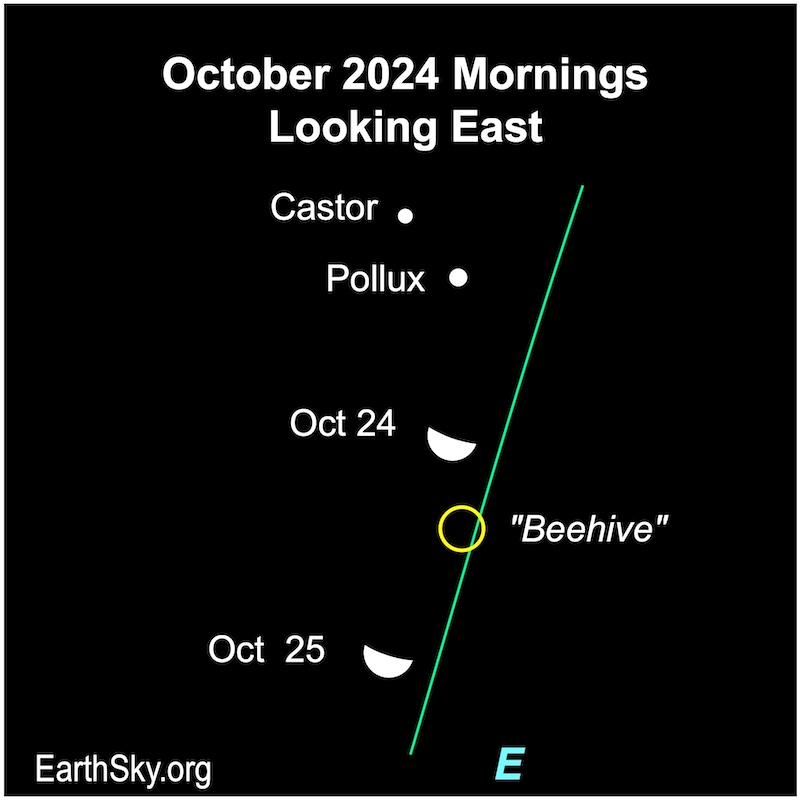
October 26 and 27 mornings: Moon and Regulus
On the mornings of October 26 and 27, 2024, the waning crescent moon will float near the star Regulus, the brightest star in Leo the Lion. Look for them a few hours before dawn.
Meet Regulus, Leo the Lion’s Heart
Our charts are mostly set for the northern half of Earth. To see a precise view – and time – from your location, try Stellarium Online.
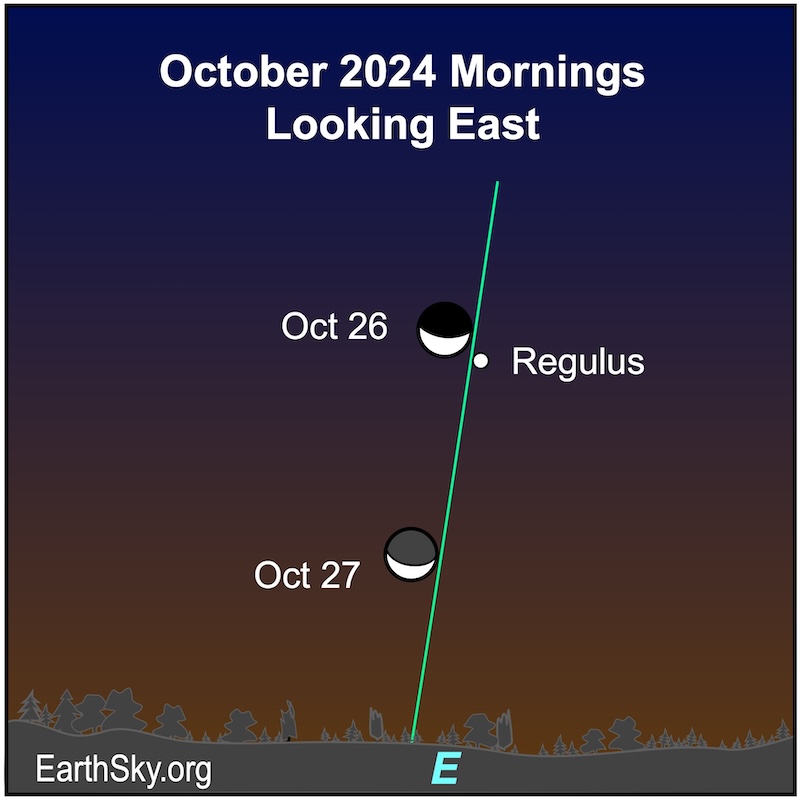
October 28 and 29 mornings: Moon and Denebola
On the mornings of October 28 and 29, the thin waning crescent moon hangs above the eastern horizon near Denebola, the end star of the tail of Leo of Lion. The dark portion of the moon will be glowing with earthshine. That’s reflected light from Earth. Look for them a few hours before sunrise.
Read: Leo the Lion and its backward question mark
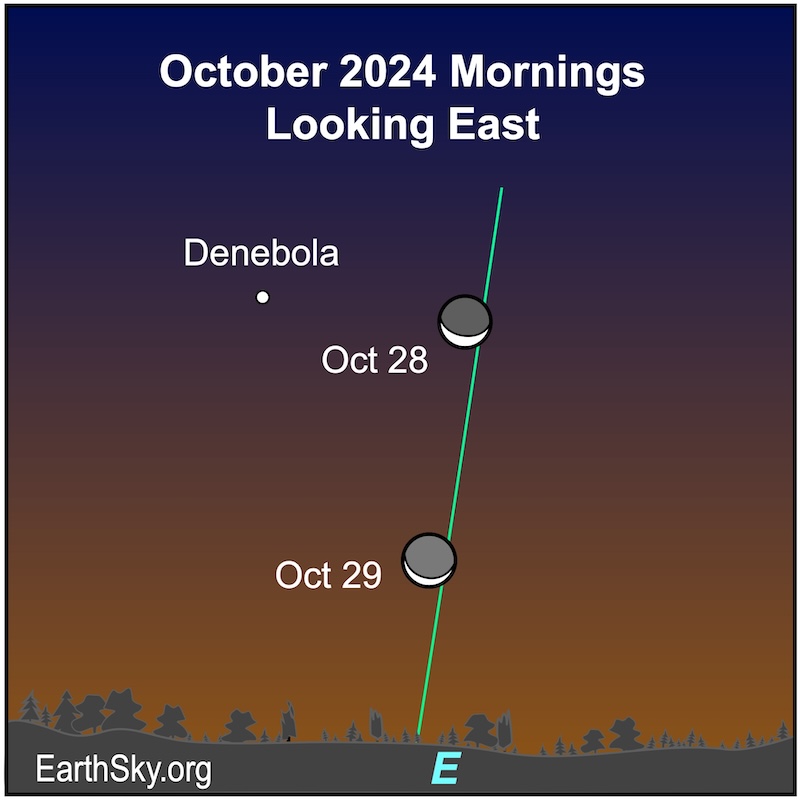
October 29: Moon reaches apogee
The moon will reach apogee – its farthest distance from Earth in its elliptical orbit around Earth – for the second time this month at 23 UTC on October 29, 2024, when it’s 252,376 miles (406,161 km) away.
October 30 and 31 mornings: Moon and Spica
On the mornings of October 30 and 31, the slender waning crescent moon hangs above the eastern horizon near Spica, the brightest star of Virgo the maiden. The unlit portion of the moon will be glowing with reflected light from Earth. That’s called earthshine. Look for them about an hour before sunrise.
Meet Spica, the bright beacon of Virgo, is 2 stars
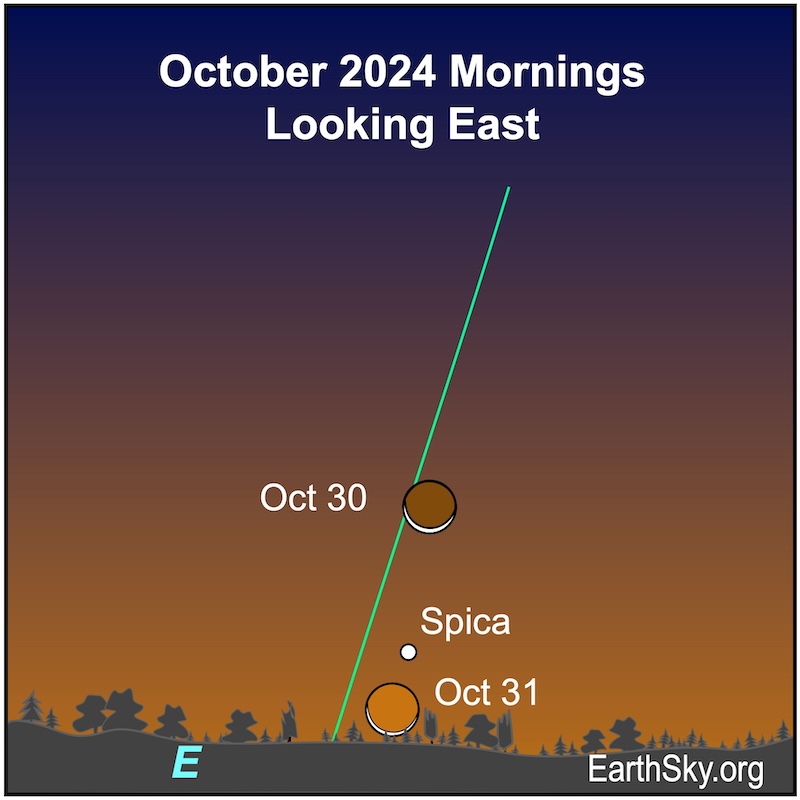
Stargazing tips for beginners
Watch a video of the EarthSky’s top 10 stargazing tips for beginning astronomers.
Stars and constellations high in the sky during October
If you’re out stargazing on any October evening, look for these stars and constellations overhead in the sky.
Cepheus
The house-shaped constellation Cepheus the King lies in the northern sky near the constellation Cassiopeia and the north pole star, Polaris. The star Delta Cephei was a key to determining distances in the universe.

The Northern Cross
The Northern Cross is a clipped version of the constellation Cygnus the Swan. It’s an asterism, or pattern of stars that’s not a recognized constellation. It lies embedded within another much larger asterism: the Summer Triangle. You’ve got to have a dark sky and a good imagination to see a swan in the stars of Cygnus. But the Northern Cross is easy to see, even if your sky is less than pristine.
The brightest star in Cygnus is Deneb. It marks one of the corners of the Summer Triangle. And its bright and colorful double star, Albireo, is one of the finest in the heavens.
Then once you’ve found Cygnus, and you’re under dark skies, look along its length to find the hazy cloud behind it that is our galaxy, the Milky Way. The Milky Way, notably, runs along the same axis as the long line of the lowercase t or the body of the Swan.
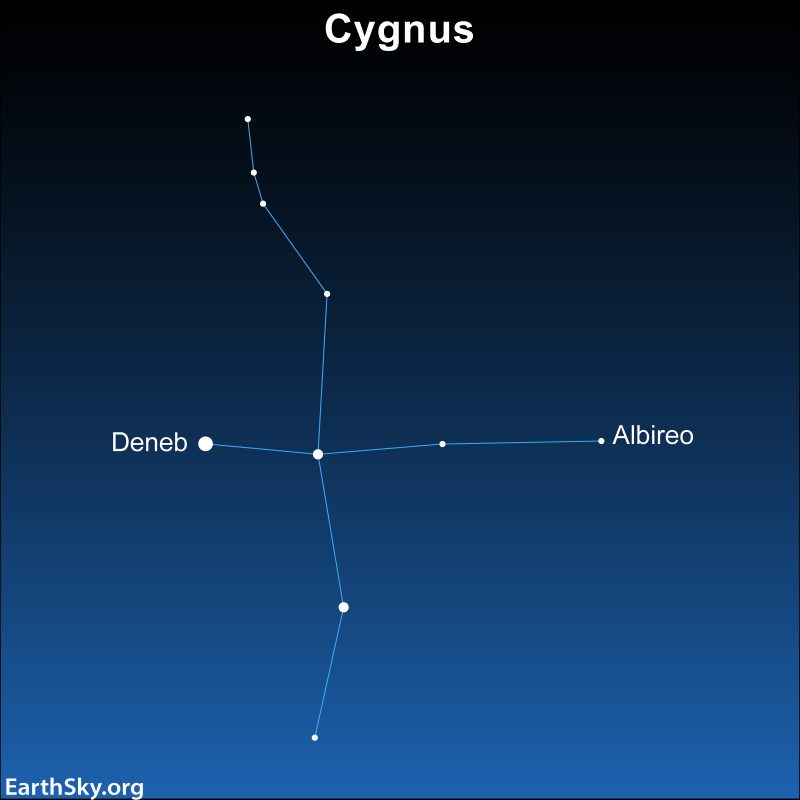
Aquila
The best time to see the constellation of Aquila the Eagle in the evening sky is from July to November, as it soars along the Milky Way. And, because our galaxy provides a starry backdrop, many clusters and nebulae lie within its borders. Aquila’s brightest star, Altair, is the southernmost corner star in the Summer Triangle. In addition, you can also use Aquila to starhop your way to the Wild Duck Cluster in Scutum.
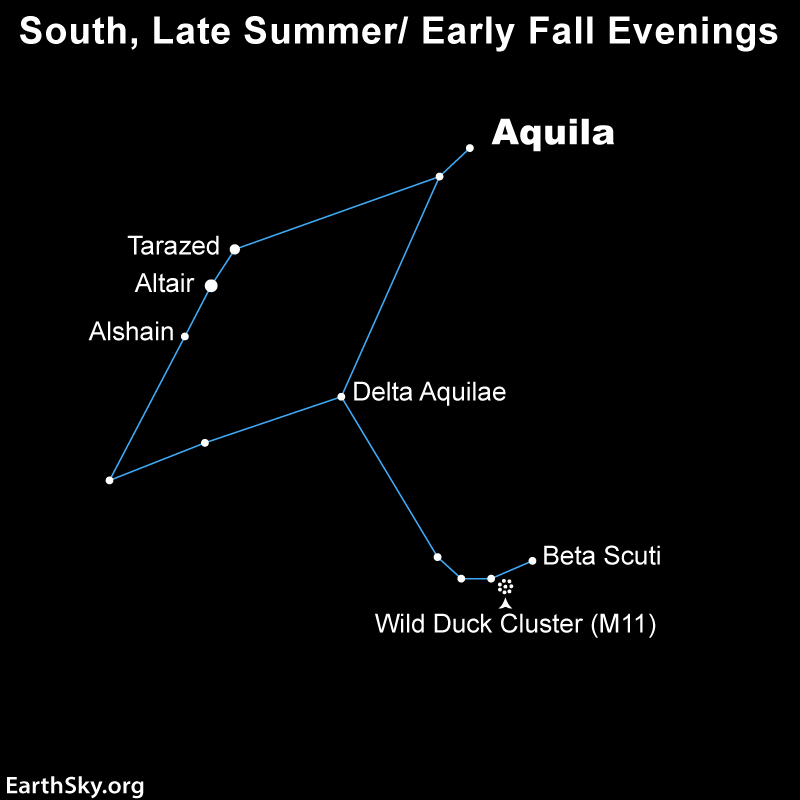
Our charts are mostly set for the northern half of Earth. To see a precise view – and time – from your location, try Stellarium Online.
October morning planets
In October 2024, red Mars will slide by the twin stars of Gemini, Castor and Pollux. It’ll rise before midnight and will be obvious in the sky before dawn. It brightens a bit this month and will be at its closest and brightest again in January 2025.

October evening planets
In October 2024, Jupiter will shine brightly near the bright stars Capella and Aldebaran. Also nearby is the Pleiades star cluster. Jupiter rises late evening and is prominent through dawn. The moon will be near Jupiter on October 20 and 21. Jupiter will be closest and brightest for 2024 in December.
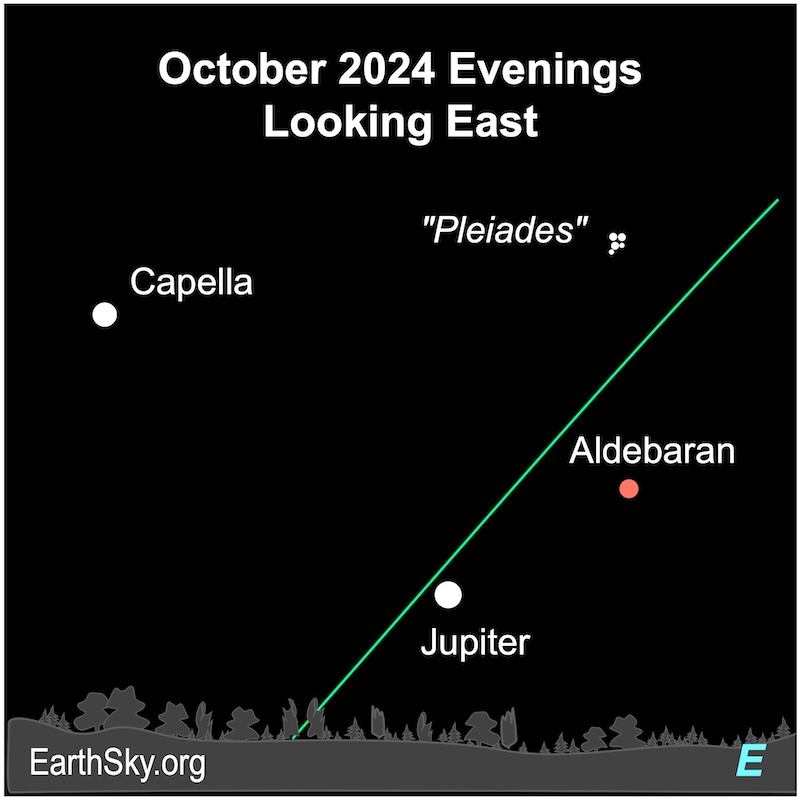
In October 2024, Venus will lie low along the western horizon shortly after sunset. On October 5, the thin waxing crescent moon will float near Venus. In the middle of the month, Venus approaches Antares, the brightest star in Scorpius the Scorpion, passing it on October 25. The rest of the month finds the bright planet hanging low in the southwest shortly after sunset. Venus will continue to ascend and become a dazzling evening star through the end of the year. It’ll reach its greatest distance from the sun in January 2025.
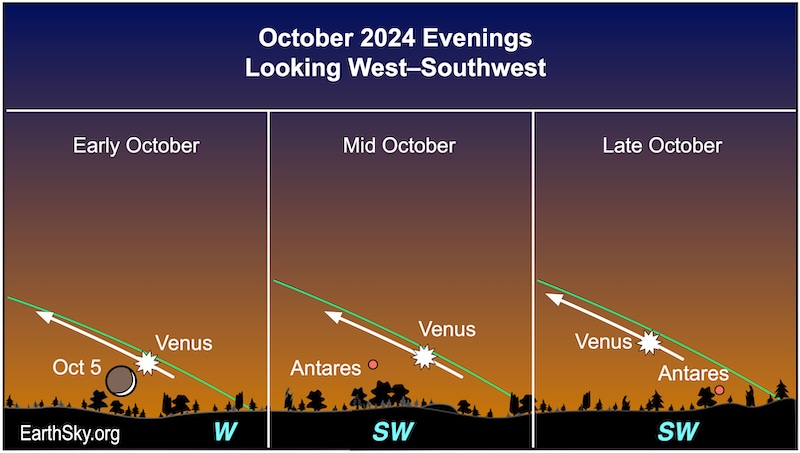
In October 2024, Saturn will be well above the eastern after sunset and visible until a few hours before dawn. It will be racing away from its closest point to Earth on September 8, when it was directly opposite the sun from Earth. The moon will float near Saturn on October 13 and 14. For the rest of 2024, Saturn will remain visible in the evening sky and will disappear in the sunset glare in February 2025.
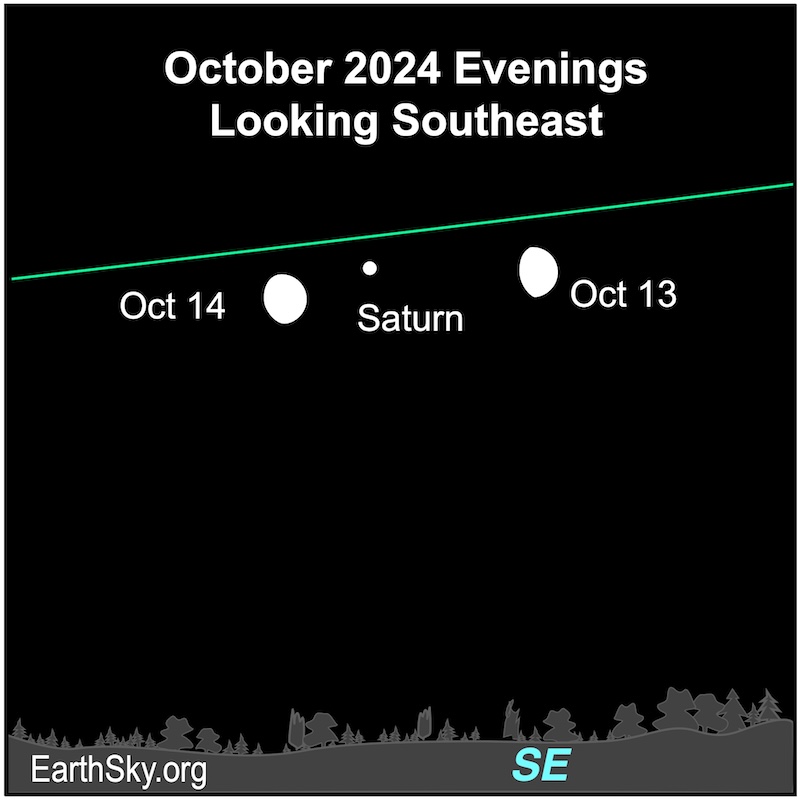
In October 2024, Mercury will slowly emerge low in the bright western twilight later in the month. Look for it about 30 minutes after sunset. It will reach its greatest elongation – greatest distance from the sunset – on November 16, 2024. Brilliant Venus will be nearby.
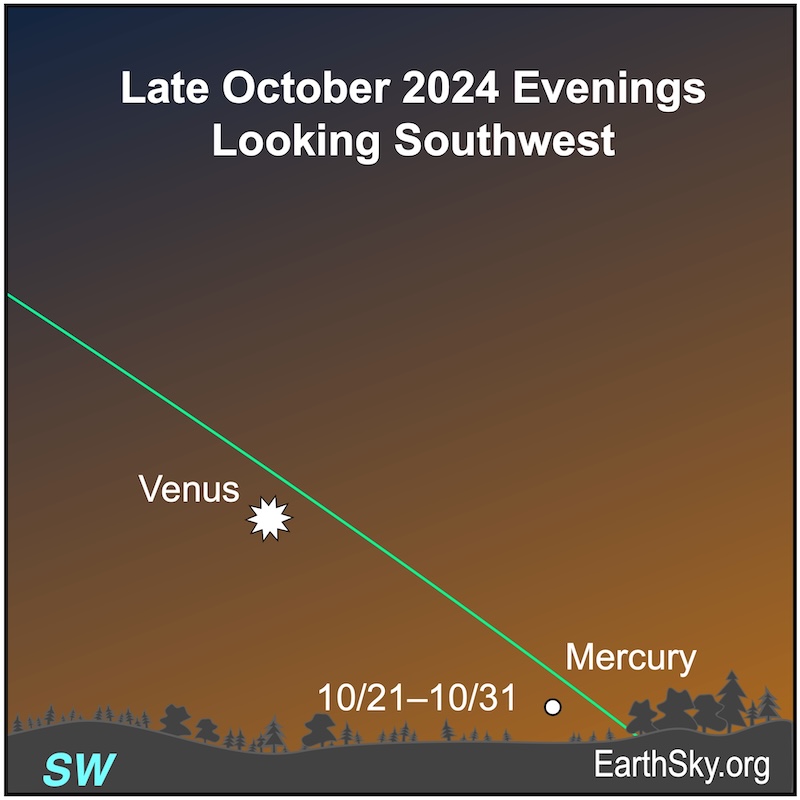
Sky dome maps for visible planets and night sky
The sky dome maps come from master astronomy chart-maker Guy Ottewell. You’ll find charts like these for every month of 2024 in his Astronomical Calendar.
Guy Ottewell explains sky dome maps
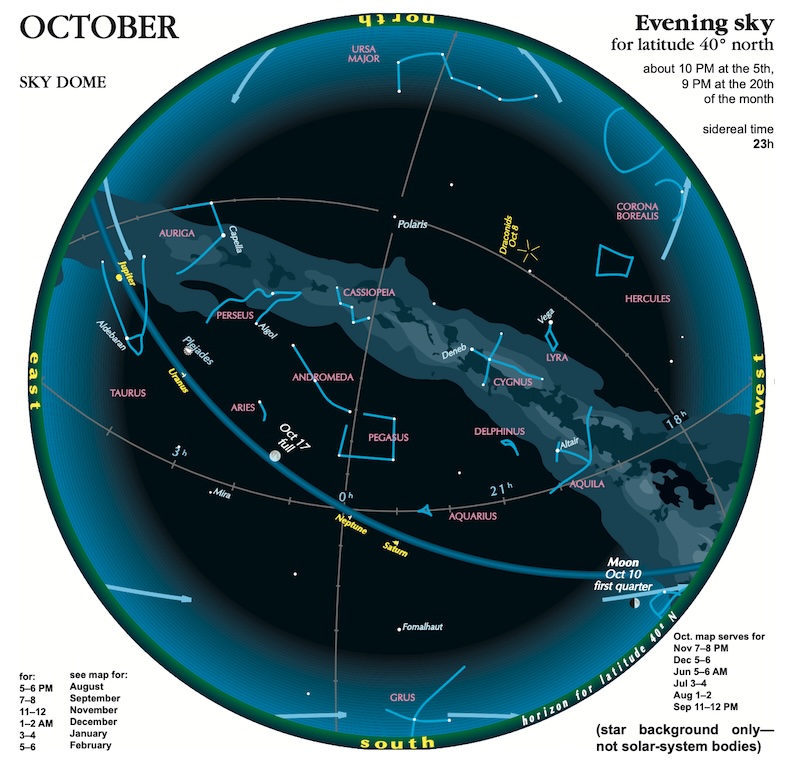
Heliocentric solar system visible planets and more
The sun-centered charts come from Guy Ottewell. You’ll find charts like these for every month of 2024 in his Astronomical Calendar.
Guy Ottewell explains heliocentric charts.
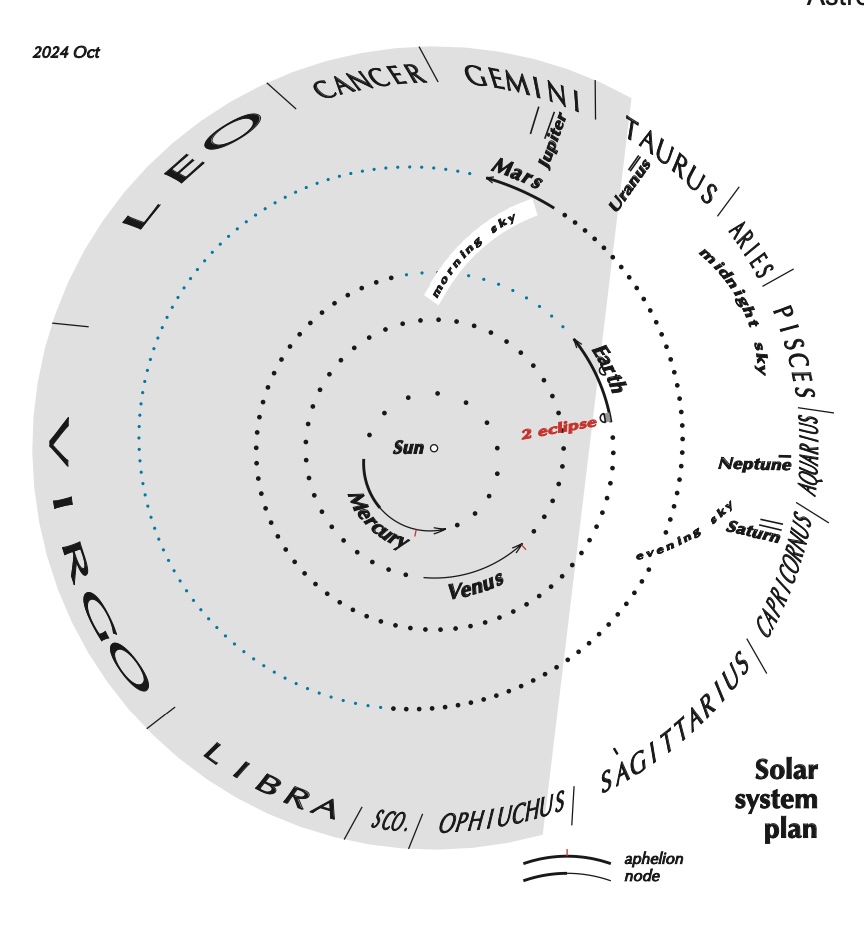
Some resources to enjoy
For more videos of great night sky events, visit EarthSky’s YouTube page.
Don’t miss anything. Subscribe to daily emails from EarthSky. It’s free!
Visit EarthSky’s Best Places to Stargaze to find a dark-sky location near you.
Post your own night sky photos at EarthSky Community Photos.
See the indispensable Observer’s Handbook, from the Royal Astronomical Society of Canada.
Visit Stellarium-Web.org for precise views from your location.
Almanac: Bright visible planets (rise and set times for your location).
Visit TheSkyLive for precise views from your location.
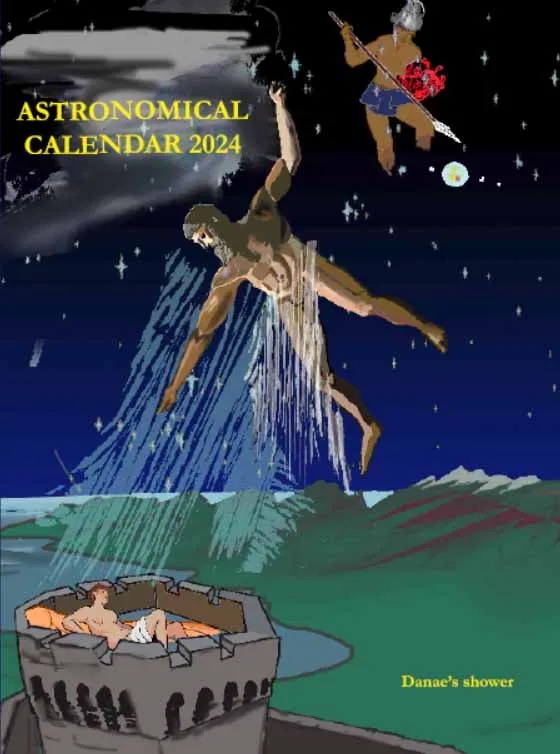
Bottom line: Visible planets and night sky guide for October 2024. This evening, look for the bright red star Antares, the Heart of Scorpius the Scorpion, close to the growing waxing crescent moon.











